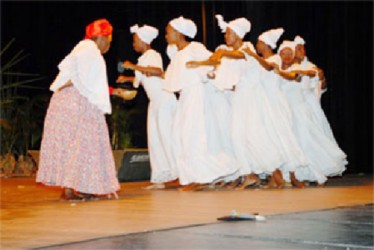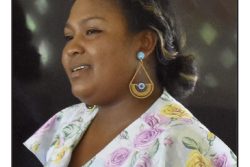The Enchanted Caribbean is one of the annual productions of the National Dance Company. The company also produces other shows which focus on themes and seasons befitting different celebrations and times of the year in addition to the Dance Season – the premier show which best highlights its work and main preoccupations. Dance Season 35, the high point of the company’s year, is scheduled for performance on October 10, 11 and 12, later this year.
Christmas Fantasia, an obvious celebration of the Christmas season, is held each year in December with themes of that particular time of year dramatised in dance. The imagination is customarily allowed to take the opportunity to explore subjects, ideas and metaphors either inspired by the festival, or designed to inspire its celebration. This production has become a part of the tradition of Christmas theatre.
Thoughts of Love is another of these focused dance shows in which the company usually appears in a somewhat lighter mood. It is the ‘Valentine’s Day’ show, performed on stage at the Theatre Guild Playhouse annually at a date close to February 14. Again, it uses the occasion to treat the theme of love with choreographies which range from humour to deep emotions and conflict. There is a tendency to create dances based on story-lines carried by popular love songs, which is a lighter (or slighter) side of the company, as opposed to its weightier and more memorable work. The theme of love, however, has been one of the most important, most popular and most widely treated subjects throughout the history of Western performance and art – in literature, music, oral literature such as folk ballads, the courtly love tradition, and travelling performers such as the troubadours.
 Celebrations of African Heritage is yet another of the shows with a pointed thematic focus. It is done around the season of Emancipation and is again obvious in the opportunity it takes to celebrate the African heritage. The company explores African dance in different ways, including form and subject, music, images, motifs and themes. They will have, quite likely, researched the large and varied area of African dance, which, for a Caribbean country like Guyana, will include not only what comes from the vast continent, but the traditions and vestiges that persist in local villages and communities. The latter remains an area wanting in proper research and attention. There is great excitement in store for dance here.
Celebrations of African Heritage is yet another of the shows with a pointed thematic focus. It is done around the season of Emancipation and is again obvious in the opportunity it takes to celebrate the African heritage. The company explores African dance in different ways, including form and subject, music, images, motifs and themes. They will have, quite likely, researched the large and varied area of African dance, which, for a Caribbean country like Guyana, will include not only what comes from the vast continent, but the traditions and vestiges that persist in local villages and communities. The latter remains an area wanting in proper research and attention. There is great excitement in store for dance here.
Dance Season, however, is the zenith of achievement, the most serious show of the year when the National Dance Company makes its major statement. The Season defines the company, although the group does not always approach it in this way. It has new ideas each year and normally shows off many new choreographical works and pursues many new interests. It is not a repertory company and rarely revisits any of the truly great dances of its recent or distant past. What I mean is, some companies will repeatedly bring back their best pieces in successive years. For example, the Caribbean’s flagship company, the NDTC of Jamaica, often goes into its repertoire to perform some of the leading and most demanded Nettleford classics like Kumina or Pocomania, which they have repeated in successive ‘Seasons.’

Guyana’s National Dance Company (NDC) uses these smaller shows to keep its own interest and its audience alive throughout the year. Not only does it continually remind the public of its presence, but delights them with these topical performances. It also provides opportunities for the NDC to go off into these themes for fresh ideas as well as for research. Research is a vital occupation for a national company, given its function in this case as an advanced extension and a theoretical arm of the national Dance School. The NDC explores dance at a higher, more thorough and specialised level.
The Enchanted Caribbean 10 directed by Vivienne Daniel, who leads the NDC, was particularly noticed for its use of interesting research. Investigations into areas of Caribbean dance and culture were a hallmark of the show. This production is usually performed close to Caricom Day, the first Monday in July and a national holiday in Guyana, around the time of the annual summit meeting of the Caricom heads of government. Most likely the thematic focus is the Caribbean countries and perhaps the Caribbean performance culture.
This year’s show, the tenth in the series in the year of the NDC’s 35th anniversary, seemed to have paid tribute to the four founding nations of Caricom – Jamaica, Trinidad and Tobago, Barbados and Guyana. Prime Ministers Michael Manley, Eric Williams, Errol Barrow and Forbes Burnham met in 1973 to establish the Common Market by what later became the Treaty of Chaguaramas. This was the reference point in one segment of the programme titled ‘A Treaty of Four and More’ in which there was a dance devoted to each of those nations.
The tribute to Barbados provided the show with its most memorable and outstanding choreography, danced by the National Dance Company and designed by Vivienne Daniel to the music of Barbadian Anthony Carter. The music is ‘Emmerton,’ the best and most acclaimed song written by Carter. This was chosen by Daniel to represent Barbados, and while it has been hallowed as a patriotic song and a virtual anthem in that country, it is really a song of protest. Carter is very famous as The Mighty Gabby, arguably the best Barbadian calypsonian of all time. But ‘Emmerton’ is not a calypso – it is a dirge-like ballad based on the forced movement of residents from the village of Emmerton with the help of bulldozers by the authorities.
The song is moving, and the music intoxicating if not haunting, and Daniel has produced a dance which makes very effective use of this music. It was very rhythmic with precise moves and controlled, sometimes rigid body language. The mood was thoroughly captured by disciplined dancers whose costuming and choice of colour emphatically enhanced an almost tragic sense evoked by the movement.
The tribute to Trinidad and Tobago came next in terms of artistic achievement and impact. It was danced by members of the company to the strains of ‘Rainbow people of the Trinity.’ It was a more conventional patriotic song celebrating multi-ethnicity in Trinidad. The performers did great justice to this interesting music, again very well served by costumes in the national colours of the nation. While this one will be remembered, those representing Guyana and Jamaica will not. Performed by a mixture of the Associates, the Advanced Class of the School of Dance and the NDC, they were fairly unremarkable.
However, representations of Jamaica featured prominently in, if not dominated, the programme. There were truly interesting pieces arising from research into sub-cultures and traditions resulting in outstanding work. Keeping in line with the themes of Caribbean industry and cultural life, there was a visually effective simulation of the cane fields as well as performances to the song of the ‘Coconut Woman’ and the famous chant of the banana man, ‘Day O,’ two of the Jamaican folk compositions taken over by Harry Belafonte. It was Jamaica again in the ‘Youth Kultur’ journeys into the ska, reggae and dance hall.
The real merit in these was to be found in the segment ‘Caribbean Kultur’ which visited the folk traditions. There was the quadrille, one of the folk dances of the past which exhibited an interesting European influence, particularly square dancing and the costuming. The culture of the enslaved was known for much satirical content with imitations and lampooning of European behaviour, manners, literature and theatre.
However, what went deepest into the indigenous traditions of African derivation was another of the outstanding pieces of the programme. This was called Brukins Party. It was taken from a Jamaican performance known as ‘brukins’ and is danced to a curious traditional song whose lyrics mix events that were 50 years apart.
Jubilee, jubilee
Dis is de time of Jubilee
Queen Victoria gi we free
Queen Victoria Jubilee
August maanin come again
August maanin Jubilee
Queen Victoria gi we free
The song is known as ‘August Morning’ (actually ‘Aagas Maanin’) – an obvious reference to emancipation, but it at the same time it celebrates the Golden Jubilee of the reign of Queen Victoria of England, widely feted in the Caribbean in 1888.
The NDC visited the old Jamaican Emancipation dance of ‘brukins,’ a tradition which, of course, has been fading. This kind of research by the dancers is not only commendable, but essential. It is the kind of work that is almost a sacred duty of Caribbean dancers to give life and national education to these dances and their traditions. Guyana’s National Dance Company, as a professional and theoretical extension of the National School of Dance, is keeping close to this duty.







